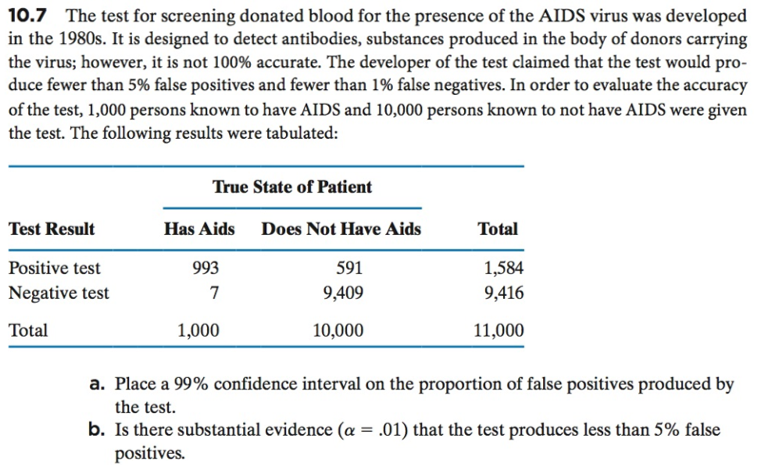10.7 The test for screening donated blood for the presence of the AIDS virus was developed in the 1980s. It is designed to detect antibodies, substances produced in the body of donors carrying the virus; however, it is not 100% accurate. The developer of the test claimed that the test would pro- duce fewer than 5% false positives and fewer than 1% false negatives. In order to evaluate the accuracy of the test, 1,000 persons known to have AIDS and 10,000 persons known to not have AIDS were givern the test. The following results were tabulated: True State of Patient Test Result Positive test Negative test Total Has Aids Does Not Have AidsTotal 993 7 591 9,409 10,000 1,584 9,416 1,000 11,000 a. Place a 99% confidence interval on the proportion of false positives produced by the test. Is there substantial evidence (α = 01) that the test produces less than 5% false positives. b
10.7 The test for screening donated blood for the presence of the AIDS virus was developed in the 1980s. It is designed to detect antibodies, substances produced in the body of donors carrying the virus; however, it is not 100% accurate. The developer of the test claimed that the test would pro- duce fewer than 5% false positives and fewer than 1% false negatives. In order to evaluate the accuracy of the test, 1,000 persons known to have AIDS and 10,000 persons known to not have AIDS were givern the test. The following results were tabulated: True State of Patient Test Result Positive test Negative test Total Has Aids Does Not Have AidsTotal 993 7 591 9,409 10,000 1,584 9,416 1,000 11,000 a. Place a 99% confidence interval on the proportion of false positives produced by the test. Is there substantial evidence (α = 01) that the test produces less than 5% false positives. b
Holt Mcdougal Larson Pre-algebra: Student Edition 2012
1st Edition
ISBN:9780547587776
Author:HOLT MCDOUGAL
Publisher:HOLT MCDOUGAL
Chapter11: Data Analysis And Probability
Section: Chapter Questions
Problem 8CR
Related questions
Question
100%

Transcribed Image Text:10.7 The test for screening donated blood for the presence of the AIDS virus was developed
in the 1980s. It is designed to detect antibodies, substances produced in the body of donors carrying
the virus; however, it is not 100% accurate. The developer of the test claimed that the test would pro-
duce fewer than 5% false positives and fewer than 1% false negatives. In order to evaluate the accuracy
of the test, 1,000 persons known to have AIDS and 10,000 persons known to not have AIDS were givern
the test. The following results were tabulated:
True State of Patient
Test Result
Positive test
Negative test
Total
Has Aids
Does Not Have AidsTotal
993
7
591
9,409
10,000
1,584
9,416
1,000
11,000
a. Place a 99% confidence interval on the proportion of false positives produced by
the test.
Is there substantial evidence (α = 01) that the test produces less than 5% false
positives.
b
Expert Solution
This question has been solved!
Explore an expertly crafted, step-by-step solution for a thorough understanding of key concepts.
This is a popular solution!
Trending now
This is a popular solution!
Step by step
Solved in 8 steps with 7 images

Recommended textbooks for you

Holt Mcdougal Larson Pre-algebra: Student Edition…
Algebra
ISBN:
9780547587776
Author:
HOLT MCDOUGAL
Publisher:
HOLT MCDOUGAL

Holt Mcdougal Larson Pre-algebra: Student Edition…
Algebra
ISBN:
9780547587776
Author:
HOLT MCDOUGAL
Publisher:
HOLT MCDOUGAL